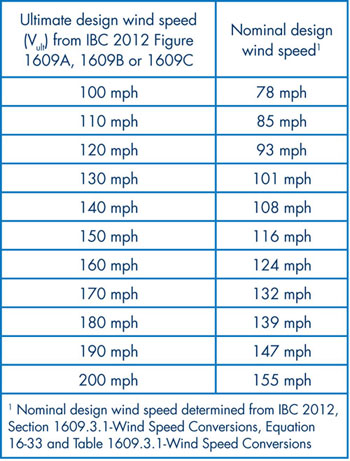Wind resistances of asphalt shingles are one of the primary performance considerations that should be evaluated when specifying asphalt shingle products. Recent changes to wind-load design procedures have resulted in a need for designers to reconsider how to specify asphalt shingles' wind resistances.
Wind resistance
Since the early 1970s, asphalt shingles' wind resistances have been tested according to a fan-induced wind test method described in ASTM D3161, "Standard Test Method for Wind-Resistance of Asphalt Shingles (Fan-Induced Method)." With this test method, asphalt shingle products are classified as Class A, D or F, which represent maximum test velocities of 60 mph, 90 mph or 110 mph, respectively.
UL 997, "Wind Resistance of Prepared Roof Covering Materials," is a test method similar to ASTM D3161 with similar classification designations.

Comparison of ultimate design wind speed values to nominal design wind speed values
When using ASTM D3161 or UL 997, designers should select an asphalt shingle product with a wind-resistance classification that exceeds the basic wind speed required by the applicable building code. This basic wind speed value, sometimes referred to as nominal design wind speed, is designated as Vasd.
In 2005, an alternative wind-resistance test method was developed for asphalt shingles that takes into consideration the uplift force applied to shingles' self-sealant strips. This test method, described in ASTM D7158, "Standard Test Method for Wind Resistance of Asphalt Shingles (Uplift Force/Uplift Resistance Method)," classifies asphalt shingle products as Class D, G or H, representing passing basic wind speeds of 90 mph, 120 mph or 150 mph, respectively.
ASCE 7-10 and IBC 2012
With the publication of ASCE 7-10, "Minimum Design Loads for Buildings and Other Structures," the basic wind speed map from ASCE 7's previous editions has been replaced with three new maps with ultimate design wind speed (Vult) values instead of the Vasd value in previous editions. The new Vult values are somewhat higher than the Vasd values. For example, a Vasd of 90 mph previously applied to most of the continental U.S. Using ASCE 7-10, a Vult of 115 mph now applies to Occupancy Category II buildings for most of the same region.
ASCE 7-10 and its revised maps are incorporated in the International Building Code, 2012 Edition. As a result, Vult now serves as the basis for wind load determination, which includes the required wind-resistance classifications for asphalt shingles, in the jurisdictions where IBC 2012 applies.
In IBC 2012's Section 1609.1-Wind Speed Conversion, an equation and table are provided for converting IBC 2012's Vult values to Vasd values. Such a conversion is necessary when using asphalt shingle products' wind-resistance classifications.
A comparison of Vasd values applicable to specific Vult values is provided in the figure.
Being aware
Revisions of ASCE 7-10's wind-load design procedures and IBC's 2012 wind speed maps have changed the code-required minimum design wind speeds applicable to buildings, including roof systems, where IBC 2012 applies. Because asphalt shingle products are tested and classified for wind resistance based on previous wind maps, conversion of the code's current Vult values to Vasd values is necessary to accurately use ASTM D3161, UL 997 or ASTM D7158's classifications.
Designers should specify the wind resistances of asphalt shingle products after taking into consideration the wind speed map contained in the applicable code.
Additional information about the wind resistances of asphalt shingles is available in NRCA Guidelines for Asphalt Shingle Roof Systems, The NRCA Roofing Manual: Steep-slope Roof Systems—2009 and from asphalt shingle manufacturers.
Mark S. Graham is NRCA's associate executive director of technical services.



